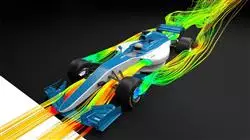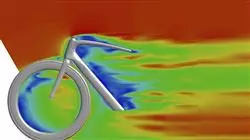University certificate
The world's largest faculty of engineering”
Introduction to the Program
Update yourself in continuous field reconstruction and stand out as an engineer prepared for all present and future challenges in the industry”

Advanced CFD Techniques are fundamental in solving engineering problems in different fields such as aerospace, automotive, energy, among others. Professionals trained in these techniques can design and analyze systems and devices with greater efficiency and accuracy, resulting in reduced costs and greater environmental sustainability, evidencing a growing need for experts in Advanced CFD Techniques to meet the demands of the industry.
In response to this growing demand, TECH has developed this program. It is a degree designed to provide a multidisciplinary and practical teaching in the application of Advanced CFD Techniques to problems. With it, graduates will acquire skills to analyze and solve complex problems in different areas of engineering, which will allow them to be more competitive in the labor market.
In addition, this program is taught in a 100% online format, which allows students to combine this learning with other activities and responsibilities. Likewise, the teaching methodology used is Relearning, which is based on the constant repetition of the most important concepts throughout the syllabus in order to achieve a natural and holistic integration of knowledge.So that graduates will be better prepared to apply Advanced CFD Techniques in the real world efficiently and dynamically. CFD techniques in the real world in an efficient and dynamic way.
Give a significant boost to your professional career by including this Diploma in your CV”
This Postgraduate certificate in Advanced CFD Techniques contains the most complete and up-to-date educational program on the market. Its most outstanding features are:
- The development of case studies presented by experts in Textile Engineering
- The graphic, schematic, and practical contents with which they are created, provide practical information on the disciplines that are essential for professional practice
- Practical exercises where the process of self-assessment can be used to improve learning
- Its special emphasis on innovative methodologies
- Theoretical lessons, questions to the expert, debate forums on controversial topics, and individual reflection assignments
- Content that is accessible from any fixed or portable device with an Internet connection
Decide how to distribute the entire teaching load, without having to adhere to complicated schedules or attend face-to-face classes”
The program’s teaching staff includes professionals from sector who contribute their work experience to this educational program, as well as renowned specialists from leading societies and prestigious universities.
Its multimedia content, developed with the latest educational technology, will provide the professional with situated and contextual learning, i.e., a simulated environment that will provide an immersive education programmed to learn in real situations.
The design of this program focuses on Problem-Based Learning, by means of which the professional must try to solve the different professional practice situations that are presented throughout the academic course. For this purpose, the student will be assisted by an innovative interactive video system created by renowned experts.
Learn more about smoothed particle hydrodynamics and become fluent in this TECH academic program"

Access a syllabus rich in content, where you will find a multitude of real examples and practical analysis that contextualize the topics covered"
Why study at TECH?
TECH is the world’s largest online university. With an impressive catalog of more than 14,000 university programs available in 11 languages, it is positioned as a leader in employability, with a 99% job placement rate. In addition, it relies on an enormous faculty of more than 6,000 professors of the highest international renown.

Study at the world's largest online university and guarantee your professional success. The future starts at TECH”
The world’s best online university according to FORBES
The prestigious Forbes magazine, specialized in business and finance, has highlighted TECH as “the world's best online university” This is what they have recently stated in an article in their digital edition in which they echo the success story of this institution, “thanks to the academic offer it provides, the selection of its teaching staff, and an innovative learning method aimed at educating the professionals of the future”
A revolutionary study method, a cutting-edge faculty and a practical focus: the key to TECH's success.
The most complete study plans on the university scene
TECH offers the most complete study plans on the university scene, with syllabuses that cover fundamental concepts and, at the same time, the main scientific advances in their specific scientific areas. In addition, these programs are continuously being updated to guarantee students the academic vanguard and the most in-demand professional skills. In this way, the university's qualifications provide its graduates with a significant advantage to propel their careers to success.
TECH offers the most comprehensive and intensive study plans on the current university scene.
A world-class teaching staff
TECH's teaching staff is made up of more than 6,000 professors with the highest international recognition. Professors, researchers and top executives of multinational companies, including Isaiah Covington, performance coach of the Boston Celtics; Magda Romanska, principal investigator at Harvard MetaLAB; Ignacio Wistumba, chairman of the department of translational molecular pathology at MD Anderson Cancer Center; and D.W. Pine, creative director of TIME magazine, among others.
Internationally renowned experts, specialized in different branches of Health, Technology, Communication and Business, form part of the TECH faculty.
A unique learning method
TECH is the first university to use Relearning in all its programs. It is the best online learning methodology, accredited with international teaching quality certifications, provided by prestigious educational agencies. In addition, this disruptive educational model is complemented with the “Case Method”, thereby setting up a unique online teaching strategy. Innovative teaching resources are also implemented, including detailed videos, infographics and interactive summaries.
TECH combines Relearning and the Case Method in all its university programs to guarantee excellent theoretical and practical learning, studying whenever and wherever you want.
The world's largest online university
TECH is the world’s largest online university. We are the largest educational institution, with the best and widest online educational catalog, one hundred percent online and covering the vast majority of areas of knowledge. We offer a large selection of our own degrees and accredited online undergraduate and postgraduate degrees. In total, more than 14,000 university degrees, in eleven different languages, make us the largest educational largest in the world.
TECH has the world's most extensive catalog of academic and official programs, available in more than 11 languages.
Google Premier Partner
The American technology giant has awarded TECH the Google Google Premier Partner badge. This award, which is only available to 3% of the world's companies, highlights the efficient, flexible and tailored experience that this university provides to students. The recognition as a Google Premier Partner not only accredits the maximum rigor, performance and investment in TECH's digital infrastructures, but also places this university as one of the world's leading technology companies.
Google has positioned TECH in the top 3% of the world's most important technology companies by awarding it its Google Premier Partner badge.
The official online university of the NBA
TECH is the official online university of the NBA. Thanks to our agreement with the biggest league in basketball, we offer our students exclusive university programs, as well as a wide variety of educational resources focused on the business of the league and other areas of the sports industry. Each program is made up of a uniquely designed syllabus and features exceptional guest hosts: professionals with a distinguished sports background who will offer their expertise on the most relevant topics.
TECH has been selected by the NBA, the world's top basketball league, as its official online university.
The top-rated university by its students
Students have positioned TECH as the world's top-rated university on the main review websites, with a highest rating of 4.9 out of 5, obtained from more than 1,000 reviews. These results consolidate TECH as the benchmark university institution at an international level, reflecting the excellence and positive impact of its educational model.” reflecting the excellence and positive impact of its educational model.”
TECH is the world’s top-rated university by its students.
Leaders in employability
TECH has managed to become the leading university in employability. 99% of its students obtain jobs in the academic field they have studied, within one year of completing any of the university's programs. A similar number achieve immediate career enhancement. All this thanks to a study methodology that bases its effectiveness on the acquisition of practical skills, which are absolutely necessary for professional development.
99% of TECH graduates find a job within a year of completing their studies.
Postgraduate Certificate in Advanced CFD Techniques
The study and application of computational fluid dynamics (CFD) is fundamental to various fields of engineering, such as aerodynamics, mechanical engineering, chemical engineering, among others. At TECH Global University we have prepared a program of Postgraduate Certificate in Advanced CFD Techniques so that students can deepen their knowledge and management of this discipline, and thus develop innovative solutions to complex problems in the industry. The course will cover topics such as numerical flow simulation, turbulence theory and heat transfer modeling. In addition, the use of advanced software tools for performing simulations in different application areas will be put into practice.
The use of advanced software tools for performing simulations in different application areas will be put into practice.
The application of advanced CFD techniques has become essential for the design and development of industrial processes and innovative products. Our Postgraduate Certificate offers practical and up-to-date training in fluid simulation and modeling techniques, focused on solving real industry problems. In this program, students will have the opportunity to acquire skills and knowledge in areas such as heat transfer modeling in combustion processes, simulation of fluid flow in equipment and mechanical components, and optimization of mixing and stirring processes. With this course, students will be prepared to face industry challenges, and will be able to bring innovative and efficient solutions to complex problems involving fluid behavior.







